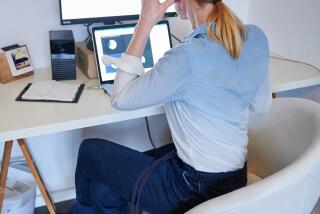A trick to reduce stress? Spend 20 seconds a day doing this easy practice

Eli Susman was a fairly experienced meditator when he attended a month-long retreat at Plum Village, a Buddhist monastery in Southern France in 2017.
The UC Berkeley PhD candidate in clinical science had been on other retreats where participants spent most of their time meditating. So he was surprised when he saw that the daily Plum Village retreat schedule included only 30 minutes of formal seated meditation a day.
Midway through the retreat he decided to extend one of his sessions, sitting beneath a tree for three hours. Later, he ran into a monk named Brother Treasure and told him about his practice. The monk’s response was not what he expected.
Unplugging is vital for our physical and mental health, right up there with diet and exercise. We journeyed around Los Angeles to unearth some of the most immersive and creative ways to do a digital detox.
“Three hours?” Susman remembers Brother Treasure telling him with a smile. “How about three breaths? That’s all it takes to step into the present moment.”
The words stuck with Susman. It led him to wonder whether an abbreviated practice that takes no more than a few breaths can make a difference in someone’s life.
Seven years later, he and his colleagues at Berkeley’s Golden Bear Sleep and Mood Research Clinic have evidence that it might. Earlier this year they published a paper online in the journal Behaviour Research and Therapy that describes how a simple 20-second self-compassion “micropractice” lowered stress levels and improved the mental health of undergraduate volunteers who did it every day for a month.
“Two of the biggest barriers people have for developing a meditation habit is having the time to do it and developing the habit of doing it regularly,” Susman said. “Micropactices are like tiny training sessions that are based on the most potent parts of therapeutic practices.”
Experts say that compartmentalizing can be a healthy and essential tool to help us get through the day.
Below, Susman describes the practice he developed for the study and explains how anyone can use it to try to feel better in less than one minute a day.
This interview has been lightly edited and condensed for length and clarity.
How do you describe the 20-second self-compassion micropractice that you studied?
The instructions we gave were to close your eyes and call to mind something about yourself that has been bothering you and making you feel unworthy, unloved or not enough and notice what arises in the body.
Then we asked people to send kindness and warmth to themselves by placing one hand over the heart and another over the belly with the energy of giving themselves a hug and notice what arises in the body now.
Next, we invited them to ask themselves, “How can I be a friend to myself in this moment?”
Finally we told them to open their eyes when they were ready.
And doing this for 20 seconds a day really made a difference in the lives of study participants?
Yes, but it only worked for people who practiced it regularly. In our study we looked at the subset of people who practiced daily and at the whole sample of people who were given the instruction.
More frequent practice was associated with greater increase in self-compassion and a greater reduction in stress and mental health problems like symptoms of depression or anxiety compared to a control group.
What are some ways that people can send kindness and warmth to themselves?
The key phrase we used in the study was “How can I be a friend to myself in this moment?” What we meant by that is imagine you were seeing a friend or your younger self in a similar situation and you were being really caring to that friend. What would you tell them to do? How would you ask them to be?
Walt Whitman inspired a former teacher’s fascination with loafing. But where should one loaf in L.A.? These parks are ideal settings for doing nothing alone or with friends.
You can also imagine yourself receiving unconditional love from someone like a mentor, a parent or a close friend. How would they relate to you in this moment of suffering? Is there a way you can give that same compassion to yourself?
Does it matter where people do this practice?
We didn’t look at that, but that’s a great question.
Why is it helpful for people to touch their stomach and chest while doing the exercise?
There has been so much work on touch and how beneficial it can be for people to receive touch, but it had not been looked at as a standalone intervention for emotional well-being in terms of people offering self-compassionate touch to themselves. I was interested in the synergy between thinking self-compassionate thoughts and doing this embodied form of self-compassionate touch. It offers two potential ways of regulating yourself.
I should also say that we told participants they could choose other forms of touch like stroking yourself on the cheeks or giving yourself a hug. What’s most important is that the method of touch supports you in feeling compassionately toward yourself.
Simple strategies for infusing more playfulness, awe and delight into your life.
I was surprised that the majority of students who participated in the study said they were too busy to do this 20-second practice everyday. What’s that about?
I was just joking with a friend about this, and she said that when people are stressed they can get wrapped up in feeling like they can’t take 20 seconds to pause. It might be more a mind-set than a reality, but there is more work to be done on how to help people feel like those 20 seconds are going to make a difference in their lives. We wash our hands for 20 seconds. We brush our teeth for two minutes. Why not take 20 seconds to do this?
Do you have any advice on how people can make this practice a habit?
It can be helpful to choose a cue. You can practice after morning coffee in the living room or whenever you’re feeling stressed if you can get yourself to do it then. The more specific you are in describing your cue and developing your plan the more likely you are to develop the practice into a habit.
Does this research suggest there is no reason to do a longer practice?
Most of the participants in our study were novice meditators or people who had never meditated before, so we don’t know how this would look with people who have a really dedicated meditation practice or are very experienced with meditation. Rigorous research is needed for whether shorter practices have advantages over longer practices, and for whom those advantages may be most pronounced.
After decades of anonymity on vitamin store shelves, magnesium is taking a star turn in L.A.’s wellness community. Here’s what it can — and can’t — do for you.
Also, just like brushing teeth is not a replacement for going to the dentist, this micropractice should not be a replacement for therapy or more intensive mental health care.
More to Read
Sign up for The Wild
We’ll help you find the best places to hike, bike and run, as well as the perfect silent spots for meditation and yoga.
You may occasionally receive promotional content from the Los Angeles Times.















